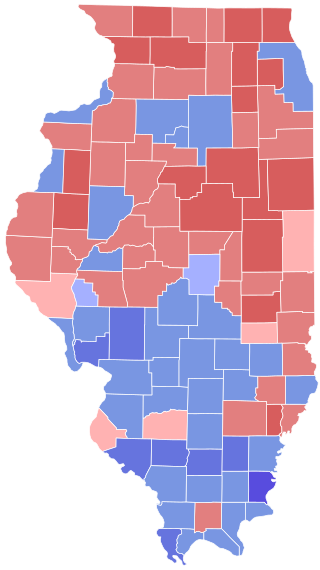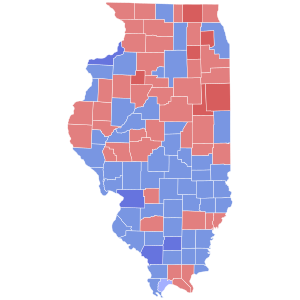
The 2006 Illinois gubernatorial election took place on November 7, 2006. Incumbent Democratic Governor Rod Blagojevich won re-election to a second four-year term scheduled to have ended on January 10, 2011. However, Blagojevich did not complete his term, as he was impeached and removed from office in 2009. This was the first election since 1964 that a Democrat was re-elected governor.

The lieutenant governor of Illinois is the second highest executive of the State of Illinois. In Illinois, the lieutenant governor and governor run on a joint ticket and are directly elected by popular vote. Gubernatorial candidates select their running mates when filing for office and appear on the primary election ballot together. When the governor of Illinois becomes unable to discharge the duties of that office, the lieutenant governor becomes acting governor. If the governor dies, resigns or is removed from office, the lieutenant governor becomes governor. Under the Illinois Constitution, the Attorney General is next in line of succession to the Governor's office after the lieutenant governor, but does not succeed to the lieutenant governor's office. From the impeachment of Rod Blagojevich in 2009, until the inauguration of Sheila Simon in 2011, Attorney General Lisa Madigan would have become governor if Pat Quinn had vacated the office. Historically, the lieutenant governor has been from either the Democratic Party or Republican Party. The current lieutenant governor is Democrat Juliana Stratton.

United States gubernatorial elections were held on November 5, 2002, in 36 states and two territories. The Republicans won eight seats previously held by the Democrats, as well as the seat previously held by Minnesota governor Jesse Ventura, who was elected on the Reform Party ticket but had since renounced his party affiliation. The Democrats won 10 seats previously held by the Republicans, as well as the seat previously held by Maine governor Angus King, an independent. The elections were held concurrently with the other United States elections of 2002.

The 2006 Illinois elections were held on November 7, 2006. On that date, registered voters in the State of Illinois elected officeholders for U.S. Congress, to six statewide offices, as well as to the Illinois Senate and Illinois House.

The 2002 Illinois gubernatorial election occurred on November 5, 2002. Incumbent Republican governor George Ryan, who was plagued by scandal, did not run for a second term. Democrat Rod Blagojevich, a U.S. Congressman, ran against Republican Jim Ryan, the Illinois Attorney General. Blagojevich won 52% to 45%, becoming the first Democrat to win an election for governor since 1972.

The 2010 Illinois gubernatorial election took place on November 2, 2010. Incumbent Democratic Governor Pat Quinn was elected to a full term in office, having become governor in 2009 following the impeachment and removal of Governor Rod Blagojevich. Quinn was elected as the Democratic nominee, the Illinois Green Party nominee was attorney and 2006 nominee Rich Whitney, the Republican nominee was State Senator Bill Brady, the Libertarian Party nominee was Lex Green, and Scott Lee Cohen ran as an independent.

The 1994 Illinois gubernatorial election was held on November 8, 1994. Incumbent Republican Governor Jim Edgar won reelection in the greatest landslide in Illinois history, excepting the elections of 1818 and 1848.

The 1986 Illinois gubernatorial election was held on November 4, 1986. Republican candidate James R. Thompson won a fourth term in office, defeating the Illinois Solidarity Party nominee, former United States Senator Adlai Stevenson III, by around 400,000 votes.

The 1990 Illinois gubernatorial election was held on November 6, 1990. Incumbent Governor James R. Thompson chose to retire instead of seeking reelection to a fifth term. Republican candidate Jim Edgar won his first of two terms in office, defeating Democrat Neil Hartigan by a narrow margin of about 80,000 votes. This election was the first open-seat gubernatorial election in Illinois since 1952.

The 1982 Illinois gubernatorial election was held in Illinois on November 2, 1982. Incumbent Republican governor James R. Thompson won a third term in office, defeating the Democratic nominee, former United States Senator Adlai Stevenson III, by a slim margin of about 5,000 votes.

The 1978 Illinois gubernatorial election was held on Tuesday, November 7, 1978. Republican James R. Thompson easily won a second term in office, defeating Democratic nominee Michael Bakalis by nearly 600,000 votes.

The 1976 Illinois gubernatorial election was held in Illinois on November 2, 1976. Incumbent first-term Democratic governor Dan Walker lost renomination to Illinois Secretary of State Michael Howlett, who was an ally of Chicago mayor Richard J. Daley. Howlett then lost the general election to Republican nominee James R. Thompson. This election was the first of seven consecutive Republican gubernatorial victories in Illinois, a streak not broken until the election of Democrat Rod Blagojevich in 2002.

The 1968 Illinois gubernatorial election was held in Illinois on November 5, 1968. Democratic nominee, incumbent governor Samuel H. Shapiro, lost reelection to Republican nominee Richard B. Ogilvie, who was the president of the Cook County Board of Commissioners and former sheriff of Cook County.

Elections were held in Illinois on Tuesday, November 6, 1990. Primaries were held on March 20, 1990.

Elections were held in Illinois on Tuesday, November 4, 1986.

Elections were held in Illinois on Tuesday, November 7, 1978.

Elections were held in Illinois on Tuesday, November 2, 1976.

Elections were held in Illinois on Tuesday, November 7, 1972.

Elections were held in Illinois on Tuesday, November 5, 1968.

The 1960 Illinois gubernatorial election was held in Illinois on November 8, 1960.


















